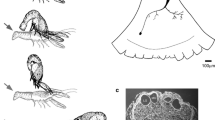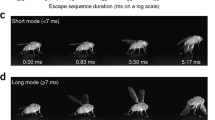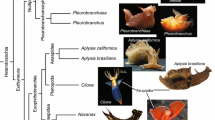Abstract
High-speed video recordings of escape responses in freely behaving crayfish revealed precisely coordinated movements of conspicuous head appendages, the antennal scales, during tail-flips that are produced by giant interneurons. For tail-flips that are generated by the medial giants (MG) in response to frontal attacks, the scales started to extend immediately after stimulation and extension was completed before the animal began to propel backwards. For tail-flips that are elicited by caudal stimuli and controlled by the lateral giants (LG), scale extensions began with significant delay after the tail-flip movement was initiated, and full extension of the scales coincided with full flexion of the tail. When we used implanted electrodes and stimulated the giant neurons directly, we observed the same patterns of scale extensions and corresponding timing. In addition, single action potentials of MG and LG neurons evoked with intracellular current injections in minimally restrained preparations were sufficient to activate scale extensions with similar delays as seen in freely behaving animals. Our results suggest that the giant interneurons, which have been assumed to be part of hardwired reflex circuits that lead to caudal motor outputs and stereotyped behavior, are also responsible for activating a pair of antennal scales with high temporal precision.






Similar content being viewed by others
References
Arnott SA, Neil DM, Ansell AD (1998) Tail-flip mechanism and size-dependent kinematics of escape swimming in the brown shrimp Crangon crangon. J Exp Biol 201:1771–1784
Card GM (2012) Escape behaviors in insects. Curr Opin Neurobiol 22:180–186
Cofer D, Cymbalyuk G, Heitler WJ, Edwards DH (2010) Control of tumbling during the locust jump. J Exp Biol 213:3378–3387
Cooke IR, Macmillan DL (1985) Further studies of crayfish escape behaviour: I. The role of the appendages and the stereotyped nature of non-giant escape swimming. J Exp Biol 118:351–365
Domenici P, Booth D, Blagburn JM, Bacon JP (2008) Cockroaches keep predators guessing by using preferred escape trajectories. Curr Biol 18:1792–1796
Dumont JP, Wine JJ (1987) The telson flexor neuromuscular system of the crayfish: III. The role of feedforward inhibition in shaping a stereotyped behaviour pattern. J Exp Biol 127:295–311
Eaton RC, Bombardieri RA, Meyer DL (1977) The Mauthner-initiated startle response in teleost fish. J Exp Biol 66:65–81
Edwards DH, Heitler WJ, Krasne FB (1999) Fifty years of a command neuron: the neurobiology of escape behavior in the crayfish. Trends Neurosci 22:153–161
Fraser K, Heitler WJ (1989) Thoracic output of crayfish giant fibres. J Comp Physiol A 166:125–132
Fraser K, Heitler WJ (1991) Photoinactivation of the crayfish segmental giant neuron reveals a direct giant-fiber to fast-flexor connection with a chemical component. J Neurosci 11:59–71
Habig C, Taylor RC (1982a) The crayfish second antennae: I. Muscles, innervation patterns and movements of antennal segments. Comp Biochem Phys A 72:339–347
Habig C, Taylor RC (1982b) The crayfish second antennae: II. Motoneuron structure as revealed by cobalt chloride backfilling. Comp Biochem Phys A 72:349–358
Heitler WJ, Fraser K (1989) Thoracic output of crayfish giant fibres. J Comp Physiol A 166:117–124
Heitler WJ, Fraser K (1993) Thoracic connections between crayfish giant fibres and motor giant neurones reverse abdominal pattern. J Exp Biol 181:329–333
Herberholz J (2009) Recordings of neural circuit activation in freely behaving animals. JOVE-J Vis Exp 29:e1297
Herberholz J, Marquart GD (2012) Decision making and behavioral choice during predator avoidance. Front Neurosci 6:125
Herberholz J, Issa FA, Edwards DH (2001) Patterns of neural circuit activation and behavior during dominance hierarchy formation in freely behaving crayfish. J Neurosci 21:2759–2767
Herberholz J, Antonsen BL, Edwards DH (2002) A lateral excitatory network in the escape circuit of crayfish. J Neurosci 22:9078–9085
Herberholz J, Sen MM, Edwards DH (2004) Escape behavior and escape circuit activation in juvenile crayfish during prey–predator interactions. J Exp Biol 207:1855–1863
Issa FA, O’Brien G, Kettunen P, Sagasti A, Glanzman DL, Papazian DM (2011) Neural circuit activity in freely behaving zebrafish (Danio rerio). J Exp Biol 214:1028–1038
Jacklyn PM, Ritz DA (1986) Hydrodynamics of swimming in scyllarid lobsters. J Exp Mar Biol Ecol 101:85–99
Johnson GE (1924) Giant nerve fibers in crustaceans with special reference to Cambarus and Palaemonetes. J Comp Neurol 36:323–373
Kramer AP, Krasne FB, Wine JJ (1981) Interneurons between giant axons and motoneurons in crayfish escape circuitry. J Neurophysiol 45:550–573
Krasne FB, Lee SC (1988) Response-dedicated trigger neurons as control points for behavioral actions: selective inhibition of lateral giant command neurons during feeding in crayfish. J Neurosci 8:3703–3712
Krasne FB, Shamsian A, Kulkarni R (1997) Altered excitability of the crayfish lateral giant escape reflex during agonistic encounters. J Neurosci 17:709–716
Larimer JL, Eggleston AC, Masukawa LM, Kennedy D (1971) The different connections and motor outputs of lateral and medial giant fibres in the crayfish. J Exp Biol 54:391–404
Liden WH, Herberholz J (2008) Behavioral and neural responses of juvenile crayfish to moving shadows. J Exp Biol 211:1355–1361
Liden WH, Phillips ML, Herberholz J (2010) Neural control of behavioural choice in juvenile crayfish. Proc R Soc Lond B Biol 277:3493–3500
Liu YC, Herberholz J (2010) Sensory activation and receptive field organization of the lateral giant escape neurons in crayfish. J Neurophysiol 104:675–684
McClenahan P, Troup M, Scott EK (2012) Fin-tail coordination during escape and predatory behavior in larval zebrafish. PLoS ONE 7:e32295
Mittenthal JE, Wine JJ (1973) Connectivity patterns of crayfish giant interneurons: visualization of synaptic regions with cobalt dye. Science 179:182–184
Neil DM, Ansell AD (1995) The orientation of tail-flip escape swimming in decapod and mysid crustaceans. J Mar Biol Assoc UK 75:55–70
Reichert H, Wine JJ, Hagiwara G (1981) Crayfish escape behavior: neurobehavioral analysis of phasic extension reveals dual systems for motor control. J Comp Physiol A 142:281–294
Ritzmann RE, Tobias ML, Fourtner CR (1980) Flight activity initiated via giant interneurons of the cockroach: evidence for bifunctional trigger interneurons. Science 210:443–445
Schadegg AC, Herberholz J (2017) Satiation level affects anti-predatory decisions in foraging juvenile crayfish. J Comp Physiol A 203:223–232
Swierzbinski ME, Herberholz J (2018) Effects of ethanol on sensory inputs to the medial giant interneurons of crayfish. Front Physiol 9:448
Swierzbinski ME, Lazarchik AR, Herberholz J (2017) Prior social experience affects the behavioral and neural responses to acute alcohol in juvenile crayfish. J Exp Biol 220:1516–1523
Wiersma CAG (1947) Giant nerve fiber system of the crayfish. A contribution to comparative physiology of synapse. J Neurophysiol 10:23–38
Wiersma CAG, Hughes GM (1961) On the functional anatomy of neuronal units in the abdominal cord of the crayfish, Procambarus clarkii (Girard). J Comp Neurol 116:209–228
Wine JJ (1984) The structural basis of an innate behavioural pattern. J Exp Biol 112:283–319
Wine JJ, Krasne FB (1972) The organization of escape behaviour in the crayfish. J Exp Biol 56:1–18
Zucker RS, Kennedy D, Selverston AI (1971) Neuronal circuit mediating escape responses in crayfish. Science 173:645–650
Acknowledgements
We would like to thank Dr. David Yager who graciously allowed us to use his high-speed video system for this project. We would also like to thank former lab members David Rotstein, Flor Orellana-Diaz, and Ashley Whiteman who contributed to the development of this project and helped with some of the initial experiments. Lastly, we would like to thank current lab members Lucy Venuti, Tawen Ho, and Norma Pena Flores for constructive discussions and their feedback on the initial draft of the manuscript. All experiments were conducted in accordance with animal care guidelines at the University of Maryland, College Park.
Author information
Authors and Affiliations
Corresponding author
Ethics declarations
Conflict of interest
The authors declare that they have no conflict of interest.
Additional information
Publisher's Note
Springer Nature remains neutral with regard to jurisdictional claims in published maps and institutional affiliations.
Electronic supplementary material
Below is the link to the electronic supplementary material.

Supplemental Figure S1:
Screenshots of single frames showing the synchronized video frames and corresponding physiological traces displayed in Photron Motion Tools for each experimental set. A) The exact time point when scale extension started during an LG tail-flip evoked with a poke to the tail. The window below the video frame shows the recordings of the bath electrodes and the alignment of the cursor with the starting point of the large neuro-muscular field potential that identifies the firing of the LG neuron. Some weak activity has been recorded before the LG neuron fires. B) The time point when the scales were half-way extended during an MG tail-flip evoked with implanted electrodes. The window below the video frame shows the cursor has moved to a position several milliseconds past the signal triggered by the stimulator that activates the implanted electrodes. C) The time point of full extension of the scales during an MG tail-flip elicited with current injection. The window below the video frame shows the position of the cursor past the signal provided by the intracellular amplifier that triggers the current injection. The traces to the right show the current injection and electrophysiological trace that recorded the MG action potential with extracellular electrodes in the ventral nerve cord rostral from the injection site. A current pulse of 300 nA was injected for 2 ms into the MG (JPEG 65 kb)
359_2019_1356_MOESM2_ESM.wmv
All videos were recorded at 2000 f/s except Movie S4, which was recorded at 1000 f/s. Videos recorded at 2000 f/s are slowed down ~ 80 × during playback, and they were slowed down further (4 ×) when prepared in Windows Live Movie Maker. The video recorded at 1000 f/s is slowed down 40 × during playback and was slowed down further (8 ×) when prepared in Windows Live Movie Maker. Thus, all movies will appear at the same playback speed. 10 s of video compares to approximately 30 ms in real time. Original video recordings were trimmed and a title page and captions for stimulus onset (for movies showing current injections) were added. No other adjustments were made. Movie S1: A poke to the head elicits an MG tail-flip. The movement of the antennal scales begins quickly after the stimulus, and extension of both scales is almost complete before the animal starts to move backward (WMV 1575 kb)
Movie S2
: A poke to the tail elicits an LG tail-flip. The movement of the antennal scales begins with considerable delay after the animal started to move, and extension of both scales is completed around the time when the tail is fully flexed and the animal moves upward (WMV 2347 kb)
Movie S3
: Electrical stimulation of the brain connective with implanted electrodes elicits an MG tail-flip. The movement of the antennal scales and body parallels the observation made with natural stimuli (WMV 1325 kb)
Movie S4: Electrical stimulation of the ventral nerve cord with implanted electrodes elicits an LG tail-flip. The movement of the antennal scales and body parallels the observation made with natural stimuli. Due to the dual camera views (from the top and from the front via a mirror), the timing between scale extension and tail flexion can be observed (WMV 3468 kb)
Movie S5
: Stimulation of a single MG neuron in the abdominal nerve cord with suprathreshold current elicits an MG tail-flip. Since the animal is pinned down, only weak body movements can be observed. However, the movement and timing of the antennal scales parallel the observation made with natural and electrical stimuli. The time of current injection into the MG neuron is illustrated by the word STIM appearing over the preparation (WMV 1146 kb)
Movie S6
: Stimulation of a single LG neuron in the abdominal nerve cord with suprathreshold current elicits an LG tail-flip. Since the animal is pinned down, only weak body movements can be observed. However, the movement and timing of the antennal scales parallel the observation made with natural and electrical stimuli. The time of current injection into the LG neuron is illustrated by the word STIM appearing over the preparation (WMV 685 kb)
Movie S7
: Stimulation of a single MG neuron in the abdominal nerve cord with suprathreshold current elicits an MG tail-flip. The left scale of the animal was moved out of its folded position with a fine brush. Upon current injection and MG activation, the scale extends from its current position. The contralateral scale starts moving at the same time from its folded position. The time of current injection into the MG neuron is illustrated by the word STIM appearing over the preparation (WMV 796 kb)
Movie S8
: Stimulation of a single LG neuron in the abdominal nerve cord with suprathreshold current elicits an LG tail-flip. The right scale of the animal was moved out of its folded position with a fine brush. Upon current injection and LG activation, the scale first moves back towards the animal’s midline (i.e., retracts) before it extends from its folded position. The retracted scale and contralateral scale start extending at similar times. The time of current injection into the LG neuron is illustrated by the word STIM appearing over the preparation (WMV 899 kb)
Rights and permissions
About this article
Cite this article
Herberholz, J., Swierzbinski, M.E., Widjaja, A. et al. Not so fast: giant interneurons control precise movements of antennal scales during escape behavior of crayfish. J Comp Physiol A 205, 687–698 (2019). https://doi.org/10.1007/s00359-019-01356-y
Received:
Revised:
Accepted:
Published:
Issue Date:
DOI: https://doi.org/10.1007/s00359-019-01356-y




